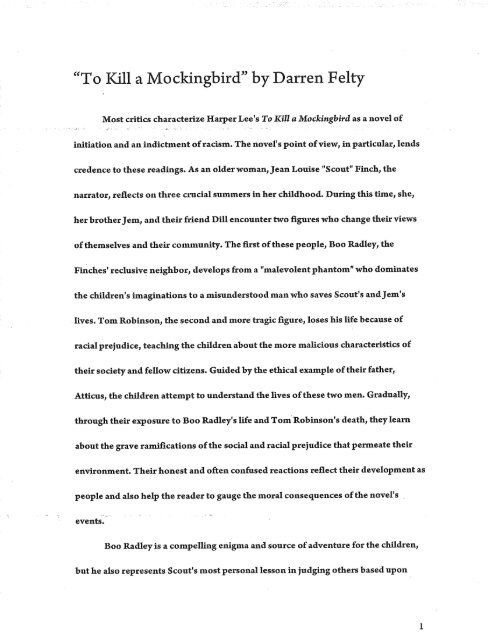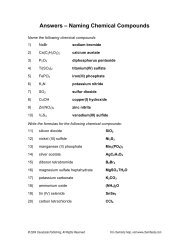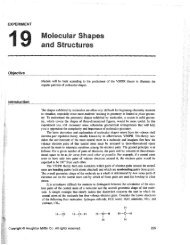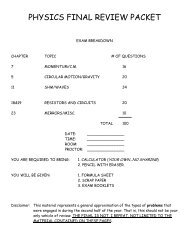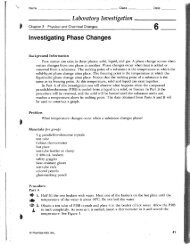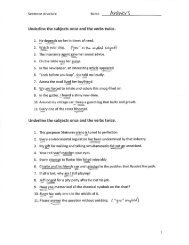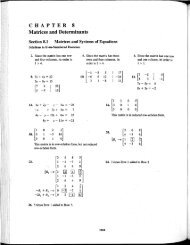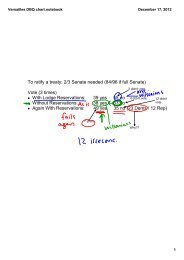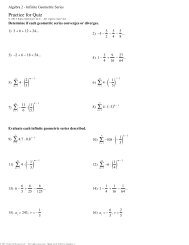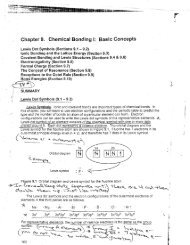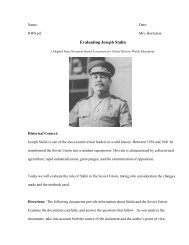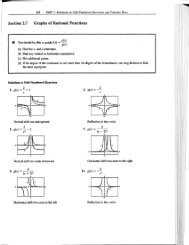"To Kill a Mockingbird" by Darren Felty
"To Kill a Mockingbird" by Darren Felty
"To Kill a Mockingbird" by Darren Felty
- No tags were found...
You also want an ePaper? Increase the reach of your titles
YUMPU automatically turns print PDFs into web optimized ePapers that Google loves.
"<strong>To</strong> <strong>Kill</strong> a Mockingbird" <strong>by</strong> <strong>Darren</strong> <strong>Felty</strong>Most critics characterize Harper Lee’s <strong>To</strong> <strong>Kill</strong> a Mockingbird as a novel ofinitiation and an indictment of racism. The novel’s point of view, in particular, lendscredence to these readings. As an older woman, Jean Louise "Scout" Finch, thenarrator, reflects on three crucial summers in her childhood. During this time, she,her brother Jem, and their friend Dill encounter two figures who change their viewsof themselves and their community. The first of these people, Boo Radley, theFinches’ reclusiv e neighbor, develops from a "malevolent phantom" who dominatesthe children’s imaginations to a misunderstood man who saves Scout’s and Jem’slives. <strong>To</strong>m Robinson, the second and more tragic figure, loses his life because ofracial prejudice, teaching the children about the more malicious characteristics oftheir society and fellow citizens. Guided <strong>by</strong> the ethical example of their father,Atticus, the children attempt to understand the lives of these two men. Gradually,through their exposure to Boo Radley’s life and <strong>To</strong>m~ Robinson’s death, they learnabout the grave ramifications of the social and racial prejudice that permeate theirenvironment. Their honest and often confused reactions reflect their development aspeople and also help the reader to gauge the moral consequences of the novel’sevents.Boo Radley is a compelling enigma and source of adventure for the children,but he also represents Scout’s most personal lesson in judging others based upon
surface appearance. In their attempts to see and communicate with Boo, the childrenenact in miniature their overall objective in the novel: to try to comprehend a world. ~ that defies.easY, rational explanation. At first, Boo represents the mysterious, theunfathomable, which to the children is necessarily malevolent. They cannotunderstand why he would remain shut away, so he must be terrifying and evil. Theyascribe nightmarish qualities to him that both scare them and stimulate theirimaginations. In Jem’s "reasonable" description of him, Boo is "six-and-a-half feettall," dines on raw squirrels and cats, bears a "long jagged scar" on his face, has"yellow and rotten" teeth and "popped" eyes, and drools. He is, in essence, a monsterwho has lost all traces of his former humanity. And <strong>by</strong> never appearing to them, Booalways plays the part the children assign him: the silent, lurking antagonist.Yet even their imaginations cannot keep the children from recognizingincongruities between their conceptions of Boo and evidence about his realcharacter. The items they discover in the tree knothole, for instance, tell them adifferent story about Boo than the ones they hear around town. The gifts of the gum,Indian head pennies, spelling contest medal, soap-carving dolls, and broken watchand knife all reveal Boo’s hesitant, awkward attempts to communicate with them, totell them about himself. The reader recognizes Boo’s commitment to the children inthese items, as do Jem and Scout after a time. The children, we see, are as fascinatingto him as he to them, only for opposite reasons. They cannot see him and mustconstruct a fantasy in order to bring him into their world; he watches them
constantly and offers them small pieces of himself so he can become a part of theirlives. The fact that Nathan Radley, Boo’s brother, ends this communication <strong>by</strong> fillingthe hole with cement underscores the hopeless imprisonment that Boo.endures,engendering sympathy both in the reader and the children.After Boo saves the children’s lives, Scout can direct her sympathy toward areal person, not a spectral presence. Because of this last encounter with Boo, shelearns firsthand about sacrifice and mercy, as well as the more general lesson thatAtticus has been trying to teach her: "You never understand a person until youconsider things from his point of view ... until you climb into his skin and walkaround in it." Boo left the safe environment of his home to risk his life for hers, andshe knows that his essential goodness and vulnerability need prote~ting. Hence, he is ~a like a mockingbird, and to assail him with public notice would be comparable todestroying a defenseless songbird who gives only pleasure to others. As she stands onhis porch, she reflects on her former behavior and feels shame: "Boo was ourneighbor. He gave us two soap dolls, a broken watch and chain, a pair of good-luckpennies, and our lives. But neighbors give in return. We never put back into the treewhat we took out of it; we had given him nothing, and it made me sad." Scout feelsremorse over the children’s isolation of Boo because of their fear and the prejudicesthey had accepted at face value. As a result of her experiences with Boo, she cannever be comfortable with such behavior again.
While Scout’s encounter with Boo Radley makes Atticus’s lessons abouttolerance tangible and personal, <strong>To</strong>m Robinson’s trial teaches her about intoleranceon a social level. But Lee,doesnot treat this ~rial solely as a means to develop Scout’scharacter. Instead, the <strong>To</strong>m Robinson story becomes the vehicle for Lee’s overtsocial criticism in the novel We see the town of Maycomb in its worst light, willing toexecute an innocent man for a crime he did not commit rather than question theirbelief in black inferiority and their social taboos about interracial relationships. Leewants to make explicit the consequences of racism and to guide the reader’sjudgment of this episode in the novel. She accomplishes these goals, in part, <strong>by</strong>employing <strong>To</strong>m Robinson’s trial to allude to the famous "Scottsboro Boys" trials of...... the1930s. These trials featured nine black defendants accused of rape <strong>by</strong> two whitewomen. Despite a lack of evidence and the questionable credibility of the witnesses,the men were sentenced to death <strong>by</strong> an all-white jury. Unlike <strong>To</strong>m Robinson,however, all of these men escaped death after a long series of new trials, in some ofwhich the defendants were still convicted in spite of the evidence. These trials, like<strong>To</strong>m Robinson’s, revealed the deep-seated racial divisions of the South and thetenacious efforts to maintain these divisions. With the "Scottsboro Boys" trials ashistorical echoes, Lee points to fundamental American ideals of equality and equalprotection under the law (as expressed <strong>by</strong> and portrayed in Atticus) to criticize thepeople’s failure to meet those ideals. Through Lee’s treatment, the white citizens ofMaycomb become hypocrites, blind to the contradictions in their own beliefs.
Hence, these people are judged, however benignly, <strong>by</strong> their own standards, standardswhich the reader shares.Many of the lessons <strong>To</strong>m Robinson’s story dramatizes escape Scout’scomprehension, but the reader still recognizes them, as does the older Jean Louise.The town of Maycomb is a sustaining force in Scout’s life, and she views ituncritically as a child and even shares its prejudices. During the trial, for instance,she answers Dill’s distress over the prosecuting attorney’s sneering treatment ofRobinson with "Well, Dill, after all he’s just a Negro." She does not experience Dill’svisceral repulsion at the trial’s racist manipulations, but instead accepts the premisethat blacks are treated as inferiors, even to the point of their utter humiliation. Butthis attitude stems mostly from her immaturity and inability to comprehend theramifications of racism. Ultimately, <strong>To</strong>m Robinson’s trial and death initiate Scout’searly questioning of racist precepts and behavior. She sees the effects of racism onher teachers and neighbors, and even feels the sting of it herself. Because of Atticus’sinvolvement with <strong>To</strong>m Robinson, for the first time the children must face the socialrejection caused <strong>by</strong> racial bias. They become victims of exclusion and insult, whichthey would never have expected.Lee poses a limitation on her social critique in the novel, however, <strong>by</strong>, ,directing it almost completely through the Finch family rather than through <strong>To</strong>mRobinson and his family. This focus makes sense given the point of view of the novel,but it still keeps the Robinson family at a distance from the reader. Calpurnia acts as
a partial bridge to the black community, as does the children’s sitting with the blacktownsp’eople at the trial, but we still must discern the tragedy of Robinson’s unjustconviction, and murder predominantly through.the reactions of white, ~not black,characters, a fact many might consider a flaw in the novel. Like the children, thereader must rely on Atticus’s responses and moral rectitude to steer through themoral complications of Robinson’s story. His is a tolerant approach, warning thereader against overharsh judgment. He teaches the children that their whiteneighbors, no matter their attitudes, are still their friends and that Maycomb is theirhome. Yet he also asserts that the family must maintain its resolve because "The onething that doesn’t abide <strong>by</strong> majority rule is a person’s conscience." We see the resultsof Atticus’s words and behavior in the older Jean Louise, who becomes acompassionate yet not uncritical member of her community, both local and national.Finally, through the Finch family’s resolve and sympathy, Lee lyricallycommunicates the need to cherish and protect those who, like mockingbirds, do noharm but are especially vulnerable to the violent injustices of our society.Source: <strong>Felty</strong>, <strong>Darren</strong>. "<strong>To</strong> <strong>Kill</strong> a Mockingbird." Novels for Students. Ed. Diane "Telgen. Vol. 2. Detroit: Gale~ 1997. p285-307.


